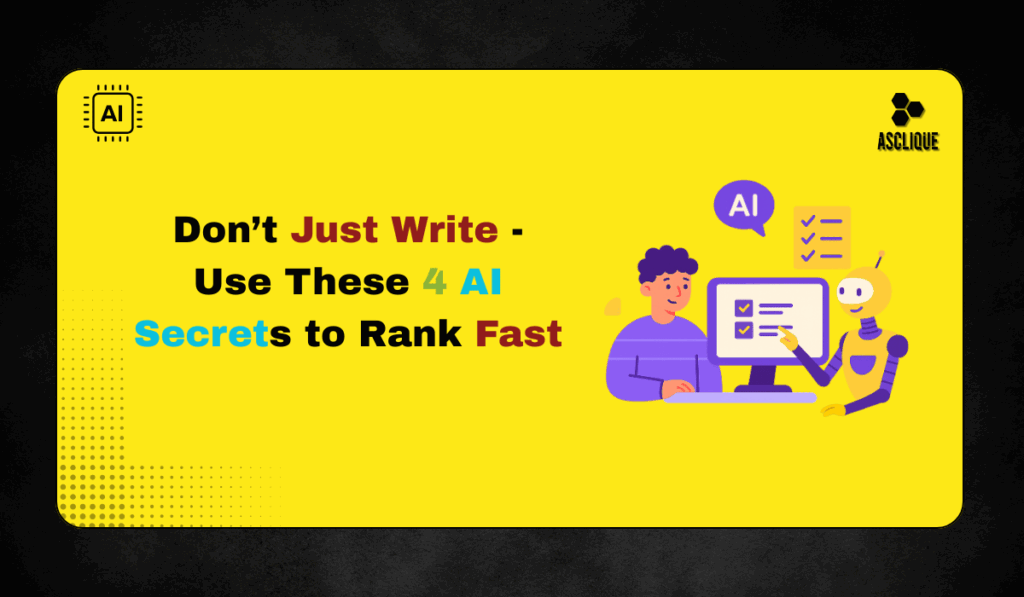Content is King—But Is Your Content Wearing the Crown?
In today’s digital landscape, creating content isn’t enough—it needs to be optimized to truly shine. If your content isn’t ranking, these AI content optimization tips can help you turn things around. As your business scales, you’ll need more content across diverse topics and keyword clusters. But is manually handling all that creation and optimization realistic? These tips help you streamline content creation while maintaining quality, relevance, and performance.
What Types of Content Should You Optimize with AI?
Just about any form of public-facing written content is a great candidate for AI-assisted optimization. This includes:
- Website content and articles
- Blog posts
- Social media posts and captions
- Pay-per-click (PPC) ad copies
- Email newsletters and drip sequences
- Landing pages
- Product and service descriptions
If you already have content that ranks well and brings in steady traffic, AI tools can also help enhance its performance even further.
But in this guide, we’ll focus on building fresh, optimized content from scratch.
AI Content Optimization: 4 Practical Strategies to Get Results
Once you’ve identified the type of content you want, there’s a process you can follow to increase the likelihood of higher rankings and user satisfaction.
Here’s how to get started:
Use AI for Keyword Research and Topic Planning
Begin by using AI-powered keyword research tools that analyze your niche and suggest content ideas, question-based queries, and keywords to target. The goal is to find high-potential terms with good search volume and low to medium competition.
For small businesses, identifying around 20–30 high-performing keywords across 3–5 broad topic categories is a good starting point.
Popular tools like Google Trends, AnswerThePublic, Ahrefs, and Ubersuggest can help you brainstorm. Once you’ve built a long list, use a tool like Surfer SEO to filter keywords by difficulty, search intent, and ranking potential. This broad-to-narrow approach helps uncover hidden SEO gems.
Generate AI Drafts with Multiple Angles
After finalizing your keywords, use AI content generators to start building article drafts. Tools like Jasper, Rytr, and Copy.ai allow you to choose tone, format, and length, then generate drafts based on your input.
ChatGPT is especially effective for producing multiple drafts. You can use it to generate website copy, blog articles, and more. Since the quality of AI output depends on the quality of your prompt, learning how to craft effective prompts is essential for success.
It’s a good idea to generate 2–3 drafts per topic. This provides flexibility and multiple angles for the same keyword, helping you better match different user intents.
Personalize the AI Output with Your Expertise
AI-generated content provides a great baseline, but it still needs your unique voice. Go through each draft, select the best version, and make it feel authentic and brand-aligned.
Focus on retaining content that directly answers user questions or delivers real value. Edit awkward phrasing, improve transitions, and ensure the final content sounds like it was written by a subject matter expert, not a machine.
Replace vague or general examples with more relatable, specific ones that resonate with your audience. Customizing the AI draft is what transforms it into polished, compelling content.
Apply On-Page SEO for Maximum Visibility
To finalize your content, enhance it with proven on-page SEO practices. Not only will this help boost your visibility on search engines, but it also improves user engagement.
Here are a few ways to optimize your content effectively:
- Use your primary keyword naturally in the title, subheadings, and intro paragraph
- Add LSI (Latent Semantic Indexing) keywords and semantically related terms throughout
- Link internally to other relevant pages within your website
- Format with bullet points, lists, and bold text for better readability
- Include relevant images and optimize them with descriptive Alt tags
- Stay updated with SEO trends and always write for both users and search engines.
Top 5 AI Tools to Supercharge Your Content Optimization
Here are five powerful AI tools designed to enhance your content creation and optimization process:
Surfer SEO
Surfer SEO uses data-driven algorithms to analyze the top-performing content in your niche. It suggests optimal keyword density, ideal content length, NLP terms, and backlink strategies to improve rankings.
Jasper AI
Jasper AI is a flexible content creation platform that crafts content across various niches. It tailors blogs, emails, and product descriptions by interpreting user intent, boosting both SEO and engagement.
Frase
Frase focuses on creating content that connects with readers and search engines alike. It evaluates top-ranking content and provides AI-driven suggestions to improve content structure, keyword usage, and engagement.
MarketMuse
MarketMuse excels at competitive analysis and content gap identification. It helps you refine structure, choose relevant keywords, and ensure your content meets user expectations more effectively.
WriterZen
WriterZen combines topic discovery, keyword research, and SEO optimization under one roof. It’s ideal for identifying golden keywords and building topic clusters aligned with user search intent.
Benefits of AI-Driven Content Optimization
Improved Rankings
AI tools help you optimize content structure, keyword placement, and SEO elements, increasing your chances of ranking higher on search engines and attracting more organic traffic.
Smarter Keyword Research
Instead of manual research, AI uncovers high-potential keywords quickly, especially those with good search volume and low competition, giving you a competitive advantage.
Time Efficiency
AI automates time-consuming tasks like drafting, editing, and formatting, allowing you to focus more on strategy, storytelling, and audience engagement.
Precise Targeting
With AI’s insights into user behavior and intent, you can craft content that speaks directly to your audience’s needs, increasing relevance and conversion potential.
Relevance and Freshness
AI tools stay updated with trends and evolving search patterns, helping you create timely, up-to-date content that keeps your brand ahead of the curve.
Consistent Quality
AI helps maintain consistency in tone, grammar, and style across your content, especially useful for teams managing high volumes or multiple content creators.
Boosted Engagement
Optimized content is more readable and relevant, keeping users on your site longer, reducing bounce rates, and increasing interaction rates.
Scalable Content Creation
With AI, you can easily scale content production without sacrificing quality, making it perfect for growing businesses with increasing content demands.
Predictive Insights
Some AI platforms can forecast content trends, helping you plan and publish content around rising topics before your competitors do.
Best Practices for AI-Powered Content Optimization
To make the most of AI, follow these proven best practices:
Blend AI with Human Insight: Let AI handle the data while you add the creativity
Prioritize Quality: Don’t sacrifice quality for the sake of speed
Keep Up with Innovation: Regularly explore new AI tools and features
Analyze Your Audience: Use AI analytics to tailor your message
Maintain Ethical Standards: Avoid deceptive practices or data misuse
Customize for Your Brand: Adjust AI settings to reflect your tone, goals, and vision
Final Thoughts
By now, you should have a strong understanding of how AI content optimization tips can transform your content strategy. The best approach involves combining the speed and efficiency of artificial intelligence with the creativity and expertise that only you bring.
It might take a bit of experimentation to discover which tools and workflows suit your brand best. But once you do, and start applying the right AI content optimization tips, you’ll be able to consistently produce high-quality content at scale—leading to greater traffic, higher engagement, and increased revenue over time.
FAQ’s
Can artificially intelligent content actually rank on Google?
Yes, but it is what you do with it. AI can assist with content structure and content creation more quickly, but to rank on Google, it must still offer genuine value. That is, original information, good formatting, good keywording, and being search intent relevant. AI is a tool, not a hack. Human touch (such as editing, adding context, and flow improvement) is what makes it great and get ranked better.
Do I require technical SEO know-how to optimize content using AI?
Not exactly—elementary SEO knowledge is sufficient to begin with. The majority of AI content tools walk you through keyword application, formatting, and readability. They’re designed to be easy to use. However, applying AI content optimization tips effectively, like understanding search intent, using proper headings, and knowing what captivates readers, will greatly improve your output.
How do I ensure AI content isn’t robotic in tone?
Read it out loud and edit as if it were a human draft. AI can do tone, but it tends to lack nuance. Put your personality in there, rephrase clunky sentences, insert anecdotes from your experience, and make the message yours. Take AI’s work and edit it like a draft, not the finished piece.
Is it plagiarism to use AI for content?
No, but you must remain vigilant. Most AI tools create original text, but sometimes, particularly with ambiguous prompts, the output sounds too familiar to existing web pages. Always copy-check (programs like Grammarly or Copyscape assist) and rephrase passages that sound too generic or repetitive. Including your own voice keeps this problem at bay as well.
How do I know if AI content is really aiding my SEO?
Monitor your metrics. Monitor for upticks in rankings, traffic, bounce rate, and time on page. Google Analytics, Google Search Console, and Surfer SEO can indicate how your AI-optimized content is doing. If you notice repeated improvement, particularly in keywords you were going for, that’s a good indication it’s working.

